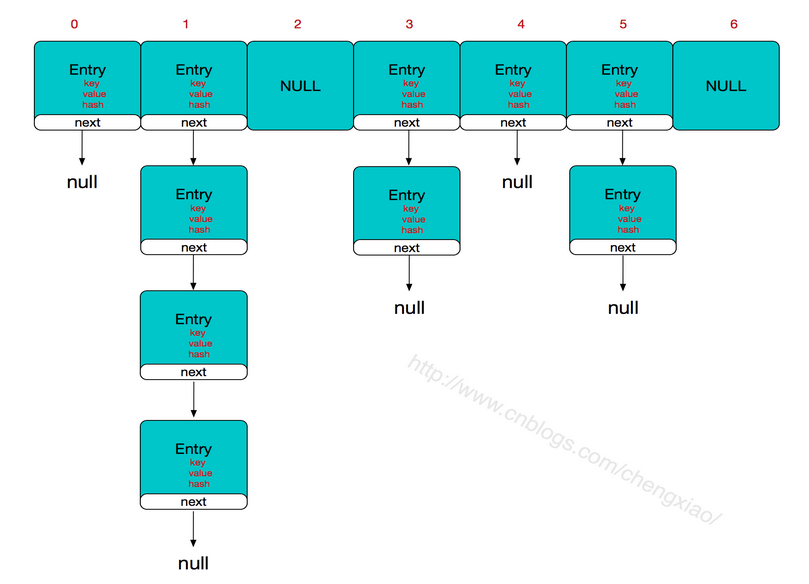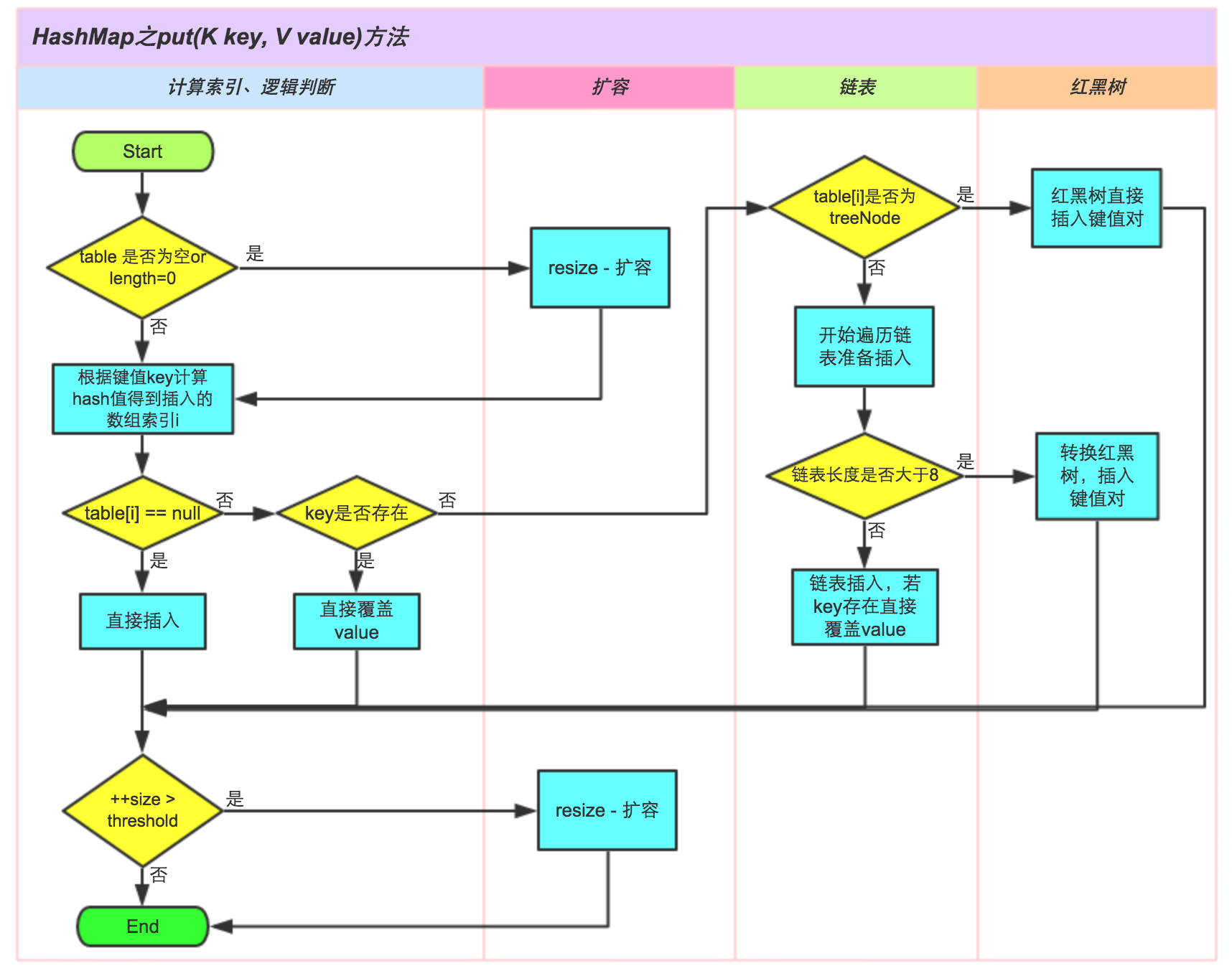本文说描述的HashMap以JDK1.8为标准进行解释。
前言: HashMap是java开发程序要使用频率比较高的一个Collection。基于哈希表的 Map 接口的实现。是以key-value的形式进行存在的。
HashMap数据结构
HashMap是以数组+链表的形式进行存储数据的(以下是代码证明)。
数组的优缺点:通过下标索引方便查找,但是在数组中插入或删除一个元素比较困难。
链表的优缺点:由于在链表中查找一个元素需要以遍历链表的方式去查找,而插入,删除快速。因此链表适合快速插入和删除的场景,不利于查找。
/**
* The table, initialized on first use, and resized as
* necessary. When allocated, length is always a power of two.
* (We also tolerate length zero in some operations to allow
* bootstrapping mechanics that are currently not needed.)
*/
transient Node<K,V>[] table;
/**
* Basic hash bin node, used for most entries. (See below for
* TreeNode subclass, and in LinkedHashMap for its Entry subclass.)
*/
static class Node<K,V> implements Map.Entry<K,V> {
final int hash;//key的hash值
final K key;//key-value结构的key
V value;//key-value结构的value
Node<K,V> next;//指向下一个链表的节点
Node(int hash, K key, V value, Node<K,V> next) {
this.hash = hash;
this.key = key;
this.value = value;
this.next = next;
}
Node节点只贴关键代码。
HashMap关键信息
默认大小为16
负载因子默认为0.75(负载因子是当hashmap中的大小达到总大小的指定负载因子时将会对hashmap进行扩容)
hashmap每次扩容为原hashmap的2倍
链表的最大长度为8,当超过8时会将链表装换为红黑树进行存储(jdk1.8新加特性)。
HashMap put时所发生的鲜为人知的事情
hashmap存放数据使用map.put(key,value)方法进行存放。
put时会先调用hash方法对key计算key的Hash值
/**
* Associates the specified value with the specified key in this map.
* If the map previously contained a mapping for the key, the old
* value is replaced.
*
* @param key key with which the specified value is to be associated
* @param value value to be associated with the specified key
* @return the previous value associated with <tt>key</tt>, or
* <tt>null</tt> if there was no mapping for <tt>key</tt>.
* (A <tt>null</tt> return can also indicate that the map
* previously associated <tt>null</tt> with <tt>key</tt>.)
*/
public V put(K key, V value) {
return putVal(hash(key), key, value, false, true);
}
hash方法的作用:高16位不变,低16位和高16位做一个异或(这样做的目的是为了减少hashcode碰撞的概率)
/**
* Computes key.hashCode() and spreads (XORs) higher bits of hash
* to lower. Because the table uses power-of-two masking, sets of
* hashes that vary only in bits above the current mask will
* always collide. (Among known examples are sets of Float keys
* holding consecutive whole numbers in small tables.) So we
* apply a transform that spreads the impact of higher bits
* downward. There is a tradeoff between speed, utility, and
* quality of bit-spreading. Because many common sets of hashes
* are already reasonably distributed (so don't benefit from
* spreading), and because we use trees to handle large sets of
* collisions in bins, we just XOR some shifted bits in the
* cheapest possible way to reduce systematic lossage, as well as
* to incorporate impact of the highest bits that would otherwise
* never be used in index calculations because of table bounds.
*/
static final int hash(Object key) {
int h;
return (key == null) ? 0 : (h = key.hashCode()) ^ (h >>> 16);
}
接下来就是真正的put方法。
put方法第二步会根据key的hash值计算当前数据需要放入数组中的哪一个index下标。
它是把当前hashmap的大小减一和key的hash值做了一个&运算。&运算就是把2个都转换成二进制数然后再进行与的运算,当且仅当两个对应的位置都是1,结果才是1,否则结果为0。这样做的目的就是为了让当前计算出来的index不超过当前数组大小,至于为什么减一是因为数组index是从0开始的。这样的话就让node落点分布均匀,减少碰撞的一个概率,如果碰撞概率高了就势必导致数组小标链表长多过长。
final V putVal(int hash, K key, V value, boolean onlyIfAbsent,
boolean evict) {
Node<K,V>[] tab; Node<K,V> p; int n, i;
// tab为空则创建
if ((tab = table) == null || (n = tab.length) == 0)
n = (tab = resize()).length;
// 计算index,并对null做处理
if ((p = tab[i = (n - 1) & hash]) == null)
tab[i] = newNode(hash, key, value, null);
else {
Node<K,V> e; K k;
// 节点key存在,直接覆盖value
if (p.hash == hash &&
((k = p.key) == key || (key != null && key.equals(k))))
e = p;
// 判断该链为红黑树
else if (p instanceof TreeNode)
e = ((TreeNode<K,V>)p).putTreeVal(this, tab, hash, key, value);
// 该链为链表
else {
for (int binCount = 0; ; ++binCount) {
if ((e = p.next) == null) {
p.next = newNode(hash, key,value,null);
//链表长度大于8转换为红黑树进行处理
if (binCount >= TREEIFY_THRESHOLD - 1) // -1 for 1st
treeifyBin(tab, hash);
break;
}
// key已经存在直接覆盖value
if (e.hash == hash &&
((k = e.key) == key || (key != null && key.equals(k))))
break;
p = e;
}
}
if (e != null) { // existing mapping for key
V oldValue = e.value;
if (!onlyIfAbsent || oldValue == null)
e.value = value;
afterNodeAccess(e);
return oldValue;
}
}
++modCount;
// 步骤:超过最大容量 就扩容
if (++size > threshold)
resize();
afterNodeInsertion(evict);
return null;
}
此图参考地址
HashMap resize()扩容
hashmap扩容是成倍的扩容。至于为什么扩容会是扩容一倍而不是1.5或者其他的倍数呢?既然hashmap在进行put的时候针对key做了一些列的hash以及&运算就是为了减少碰撞的一个概率,如果扩容后的大小不是2的n次幂的话之前做的不是白费了吗?(特别是在做&运算的时候)
else if ((newCap = oldCap << 1) < MAXIMUM_CAPACITY &&
oldCap >= DEFAULT_INITIAL_CAPACITY)
newThr = oldThr << 1; // double threshold
扩容后会重新把原来的所有的数据key的hash重新计算放入扩容后的数组里面去。为什么要这样做?因为不同的数组大小通过key的hash计算出来的index是不一样的。
HashMap多线程处理
hashmap是线程不安全的。
当多个线程同时检测到总数量超过门限值的时候就会同时调用resize操作,各自生成新的数组并rehash后赋给该map底层的数组table,结果最终只有最后一个线程生成的新数组被赋给table变量,其他线程的均会丢失。而且当某些线程已经完成赋值而其他线程刚开始的时候,就会用已经被赋值的table作为原始数组,这样也会有问题。
如果在使用迭代器的过程中有其他线程修改了map,那么将抛出ConcurrentModificationException,这就是所谓fail-fast策略。这一策略在源码中的实现是通过modCount域,modCount顾名思义就是修改次数,对HashMap内容的修改都将增加这个值,那么在迭代器初始化过程中会将这个值赋给迭代器的expectedModCount。在迭代过程中,判断modCount跟expectedModCount是否相等,如果不相等就表示已经有其他线程修改了Map
abstract class HashIterator {
Node<K,V> next; // next entry to return
Node<K,V> current; // current entry
int expectedModCount; // for fast-fail
int index; // current slot
HashIterator() {
expectedModCount = modCount;
Node<K,V>[] t = table;
current = next = null;
index = 0;
if (t != null && size > 0) { // advance to first entry
do {} while (index < t.length && (next = t[index++]) == null);
}
}
public final boolean hasNext() {
return next != null;
}
final Node<K,V> nextNode() {
Node<K,V>[] t;
Node<K,V> e = next;
if (modCount != expectedModCount)
throw new ConcurrentModificationException();
if (e == null)
throw new NoSuchElementException();
if ((next = (current = e).next) == null && (t = table) != null) {
do {} while (index < t.length && (next = t[index++]) == null);
}
return e;
}


